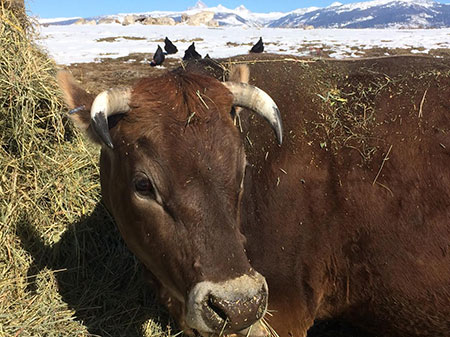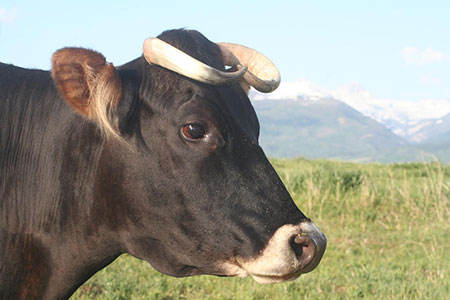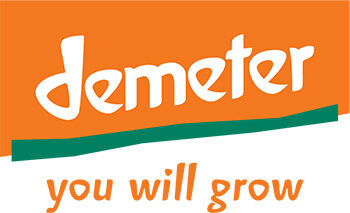Musings on Biodynamic Cows,
Their Horns, and the Evolution of the Earth
By Jim Fullmer, Co-Director of Demeter-USA
(Reprinted from the Demeter USA website, http://www.demeter-usa.org/for-farmers/for-farmers-archive/biodynamic-cows.asp)
Have you ever wondered why cows have horns…? It’s a most important question. What happens in the places where the hooves and the horns are growing? A locality is created where the incoming stream of forces is particularly strong. Rudolf Steiner- Agriculture course –lecture 4
Biodynamic ruminant production is an interesting proposition. It has its roots in the idea that a farm can be a holistic, regenerative, and self regulating system. So first off one needs to have a focus on the contribution of these meditative critters to farm system as a whole. They graze it, cycling the vegetation ruminated towards enlivened soil humus. The Demeter Farm Standard specifies that at least 1/2 of the feed has to come from the farm where the ruminants reside and 80% of it has to be Biodynamic. From a farm management perspective this creates the opportunity to cycle carbon/fertility on farm, not only from the manure produced but also the contribution of sod to a farms crop rotation, as this is a phase where, sans tillage, soil humus can be significantly developed and carbon sequestered.

For North Americans take the example of the relationship between the Bison and the native prairies upon which they roamed, a region that stretched from Canada down to Mexico. Very fertile soils were built based on this relationship. Photosynthesis is an interaction between the Earth and the Sun. The process of photosynthesis that begot the vegetation the Bison consumed along with what transpired between the Bison and the predators that regularly herded them, yielded humus, and lots of it. As we know humus holds 90% of the water of a saturated atmosphere (such as rain), it holds onto crop nutrients, cycles nitrogen and there is a yet to be discovered universe to be found in the living processes that follow the native process of ruminants massaging the Earth with their mouths. One reason that integrating livestock back into diverse cropping systems, and out of the CAFO’s, is a principle of the US Demeter Farm Standard is an attempt at bio-mimicry. The relationship between the Earth, ruminants grazing it, and the Sun is an ancient principle inherent to the organic functioning of the Earth herself. The goal is to recognize and utilize this in Biodynamic farm management.
Enter to that equation the horn… Biodynamic ruminants have horns- what’s that about? Cattle themselves have a long lineage back in evolutionary time of Ungulates that includes other horned ruminants such as goats, antelopes and giraffes. Native cattle such the Bison, Yak and Auroch have lineage to the Earth’s evolutionary DNA, void of human intervention. All were with horns. The horn itself is not just an auxiliary growth of bone protruding from the skull. On the contrary the horn is a condensed protrusion of the skin. The bone grows into it forming a boney core that is penetrated by blood cells, furnished with nerves and containing internal air spaces that develop and connect with the sinus cavities and literally the breath of the cow herself. Cattle evolved with blood filled, sentient horns that played a key role in the function and evolution of the species. In Biodynamic agriculture this matters.

Needless to say the process of dehorning is a traumatic one. This is the removal of a blood filled, sentient organ literally connected to the sinus cavities of the animal itself and is not permitted in Biodynamic certification. Cattle have been bred to be without horns (polled). Certifying polled animals Biodynamic also is not currently permitted in the Demeter Standard. This is an interesting on going conversation. There are some existing commercial beef breeds, such as Angus, that are the result of being genetically polled by human breeding close to 1000 years ago. There currently also is a strong movement towards applying CRISPR technology to breeding polled dairy cattle (something that clearly would not be permitted in Biodynamic production). Lots to consider in this discussion. Regardless where the conversation on polled cattle goes core to the philosophy of Biodynamic agriculture is the idea that this blood filled sentient organ (the horn) functions as a “locality where the incoming stream of forces is particularly strong”, core to the inherent being of a cow and its relation to the land where it resides.
Those who have traveled in Europe may have noticed when crossing the countryside that many of the cows seen grazing the truly pastoral scenery have horns. In North America such as sight is much more rare, unless one is fortunate to be passing a Biodynamic farm. Particularly in the North American organic dairy reality the fact that Biodynamic dairy cows need to have horns poses an interesting challenge to organic dairy folks that might ponder transition to a Biodynamic system. Horns on dairy cattle play a key role in the social arrangement of the herd. Cows will exhibit such social engagement with or without horns but cows in settings not designed to support the fact the herd has horns have difficulty thriving. The infra-structure of barns, holding areas, milking parlors etc. has to be developed with the space and flow considerations of a horned herd. A horned herd that has the space and the management focus to allow the species to play out its own inherent bovine character can exist and thrive just fine. On the contrary its difficult to try to stuff a horned herd into an infrastructure designed for hornless cows.

Those that have existed with cows, in particular, in their life may have noticed that they are truly sweet and meditative animals- inwardly focused in a big way via the process of rumination (“A locality is created where the incoming stream of forces is particularly strong”…). Happy cows, eating grass, as they should, spend a fair amount of time in a deep contemplative state known as rumination. They lie there chewing their cud, which is this amazing process of chomping consumed vegetation with their Earth laden mouths as it is also being inoculated with native generated microbial life with a strong kinship to the Earthly process of decaying the results of photosynthesis back to humus. Truly an amazing process.
For more information, read the following report published by FiBL and Demeter International:
